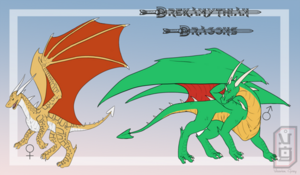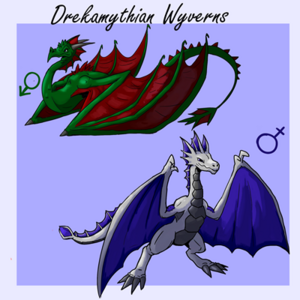Dragons in Anagonia: Difference between revisions
| Line 21: | Line 21: | ||
Drekamythian Dragons are known for their sexual dimorphism, with males being larger and more territorial than females. The males, standing at 63 feet in length and 14 feet in height, fiercely protect their egg chambers, often located within mountain caves. Their territorial behavior is key to the survival of the species, ensuring that only the strongest and most aggressive dragons reproduce. In contrast, the smaller females, at 43 feet in length and 9 feet in height, exhibit a more curious and gentle nature. They are often seen interacting with humans and other creatures with a degree of tolerance, though they will still defend their nests if necessary. | Drekamythian Dragons are known for their sexual dimorphism, with males being larger and more territorial than females. The males, standing at 63 feet in length and 14 feet in height, fiercely protect their egg chambers, often located within mountain caves. Their territorial behavior is key to the survival of the species, ensuring that only the strongest and most aggressive dragons reproduce. In contrast, the smaller females, at 43 feet in length and 9 feet in height, exhibit a more curious and gentle nature. They are often seen interacting with humans and other creatures with a degree of tolerance, though they will still defend their nests if necessary. | ||
Dragons are semi-intelligent to highly intelligent, and their ability to communicate with humans, though rare, has led to the belief that they possess their own complex social structures. However, due to their avoidance of human settlements and interaction, little is definitively known about these structures. Fossils indicate that they have existed in some form for millions of years, evolving from the Draconus Unchanos species to the modern Draconus Drekamythus Imperius. | Dragons are semi-intelligent to highly intelligent, and their ability to communicate with humans, though rare, has led to the belief that they possess their own complex social structures. However, due to their avoidance of human settlements and interaction, little is definitively known about these structures. Fossils indicate that they have existed in some form for millions of years, evolving from the ''Draconus Unchanos'' species to the modern ''Draconus Drekamythus Imperius''. | ||
==Biological Characteristics: Wyverns== | ==Biological Characteristics: Wyverns== | ||
Revision as of 22:31, 6 October 2024
For millions of years, the Drekamythian Dragons and Wyverns have soared the skies and ruled the rugged landscapes of Anagonia, evolving from ancient reptilian ancestors that once thrived during the prehistoric Pangea era. Fossil evidence suggests that these creatures first emerged around 50 million years ago, evolving slowly over millennia as the landmasses split, isolating populations and forcing unique adaptations. The modern Drekamythian Dragon, Draconus Drekamythus Imperius, and the Wyvern, descended from these ancient species, exhibit impressive biological and behavioral characteristics that place them among the most revered creatures in Anagonian culture.
While dragons are known for their intelligence, larger size, and complex social behaviors, wyverns are more elusive and agile, carving out their own evolutionary niche. Though once spread across multiple continents, these creatures now primarily reside on Minor Kistavich, where conservation efforts ensure their survival in the wild. Dragons have also found sanctuary within the Imperial Drekamythian Empire, hidden in secluded sanctuaries. Some have migrated back to Major Kistavich in the aftermath of the Great War, settling in newly acquired Anagonian territories.
This evolutionary process, shaped by geographic isolation and adaptation to Anagonia's diverse habitats, has not only ensured their survival but also allowed them to become integral to the nation's ecological and cultural identity.
Drekamythian Dragons & Wyverns: An Overview
Drekamythian Dragons and Wyverns are legendary creatures that have played a vital role in the mythos and history of Anagonia. These ancient reptiles, with their distinct characteristics and awe-inspiring presence, symbolize the deep-rooted connection between Anagonia and its primordial past. Through millennia of evolution, these creatures have adapted to the rugged terrains and diverse climates of Minor Kistavich, maintaining a balance between the natural and mystical realms.
Drekamythian Dragons, known for their intelligence, immense size, and territorial behaviors, are often regarded as guardians of sacred lands, particularly within mountain ranges and isolated forests. Their interactions with humans are rare but deeply respected, inspiring tales of wonder and reverence throughout Anagonia’s history.
Wyverns, on the other hand, are more elusive, choosing to inhabit high mountain peaks and coastal cliffs, their swift and graceful movements making them formidable predators of the skies. Though they share common ancestry with dragons, Wyverns possess a wilder, less intellectual nature, often keeping their distance from human settlements. Together, these species embody the untamed beauty and mysticism of the Anagonian landscape, standing as living relics of a time when ancient beasts roamed the world, free and majestic.
Evolution & Species Diversity
In the distant past, the skies and mountains of Esvanovia were home to a far greater diversity of dragon and wyvern species. However, through natural selection, hunting, and environmental changes, many of these species were culled over time, leaving only a few remnants that now primarily reside on the Continent of Minor Kistavich, where mainland Anagonia is located. Some of these creatures migrated back to Major Kistavich after the Great War, when Anagonia took over additional territory. Despite their reduced numbers, they remain central figures in Anagonian culture and are particularly revered for their symbolic presence.
Drekamythian Dragons, especially those found in the Imperial Drekamythian Empire, live in seclusion, guarding ancient nesting grounds deep within mountain ranges. They maintain their ancient practices and connections to the land. In contrast, Drekamythian Wyverns are found scattered around, particularly in remote and inaccessible regions like the high cliffs and mountain ranges that border the seas.
Biological Characteristics: Dragons
Drekamythian Dragons are known for their sexual dimorphism, with males being larger and more territorial than females. The males, standing at 63 feet in length and 14 feet in height, fiercely protect their egg chambers, often located within mountain caves. Their territorial behavior is key to the survival of the species, ensuring that only the strongest and most aggressive dragons reproduce. In contrast, the smaller females, at 43 feet in length and 9 feet in height, exhibit a more curious and gentle nature. They are often seen interacting with humans and other creatures with a degree of tolerance, though they will still defend their nests if necessary.
Dragons are semi-intelligent to highly intelligent, and their ability to communicate with humans, though rare, has led to the belief that they possess their own complex social structures. However, due to their avoidance of human settlements and interaction, little is definitively known about these structures. Fossils indicate that they have existed in some form for millions of years, evolving from the Draconus Unchanos species to the modern Draconus Drekamythus Imperius.
Biological Characteristics: Wyverns
Drekamythian Wyverns, while related to Dragons, are smaller and possess distinct differences. With only two wings and no front limbs, they are built for speed and agility in the skies. The Green Mountain Wyverns are known for their dominance over mountainous regions, while the Coastal Ocean Wyverns patrol the sea cliffs and shores.
Unlike their dragon kin, wyverns are far more reclusive, with some experts speculating that they possess a unique form of intelligence. It is still debated whether Wyverns have a form of speech or writing, with many believing they may be simply too elusive to study thoroughly. Some records suggest the possibility that, like Dragons, they might communicate through non-verbal means such as body language, but no definitive proof exists to confirm this.
Cultural Impact & Religious Significance
Both Dragons and Wyverns hold deep cultural and religious significance in Anagonia. Pilgrims often embark on long journeys to view Dragons in their natural habitats, seeking wisdom and spiritual connection. These dragons have become symbols of power, wisdom, and protection, inspiring countless myths, legends, and religious practices throughout history.
In religious texts, Dragons are often depicted as sacred guardians, their presence believed to bring blessings and protection to those who revere them. Temples dedicated to ancient deities often feature statues and carvings of Drekamythian Dragons as holy figures, representing the divine connection between the mortal realm and the ancient, primordial powers of the world. In some traditions, dragons are seen as the messengers of the gods, their roars echoing as the voice of the divine across the land.
Wyverns, on the other hand, are portrayed as symbols of the wild, untamed forces of nature. Their independence and elusive nature are often romanticized in folklore, with stories describing them as the guardians of the natural world, protecting the land from those who would harm it. Their grace and ferocity are often compared to the elemental forces of the sea and sky, reflecting their roles as the protectors of Anagonia’s wilderness.
Writing, Script, and Communication
Drekamythian Dragons are believed to possess their own writing system, an ancient script passed down through generations. This script, known as Drekasii—informally known as Anagonian Draconic Script—evolved from pictographs used by their ancestors to represent the natural world and the dragon's role within it. Over time, it became a complex system of glyphs and symbols, representing everything from territorial claims to philosophical concepts about life, death, and the cosmos. This writing is often found carved into the walls of sacred dragon caverns, where they record their history and wisdom.
Wyverns, on the other hand, are less associated with written communication. Some believe they possess a form of silent language, communicated through gestures, wing movements, and subtle changes in body posture. Others speculate that they might communicate telepathically or through an unknown sensory mechanism, allowing them to coordinate complex aerial maneuvers and navigate the treacherous skies of Anagonia.
Popular Culture & Modern Portrayal
In modern Anagonian culture, Dragons and Wyverns continue to captivate the imaginations of the public. They are featured in literature, art, and film, often portrayed as both fearsome beasts and noble creatures deserving of respect. Dragons are frequently depicted as protectors of the realm, while Wyverns are seen as the embodiment of freedom and the wild spirit of the natural world.
In popular media, the image of the Drekamythian Dragon as a guardian figure has been cemented, with many stories and films depicting them as ancient beings watching over humanity. Wyverns, though less common, are often shown as swift and deadly hunters, their agility and power making them formidable creatures in stories and games alike.

